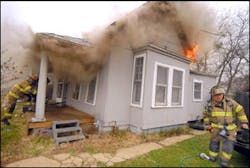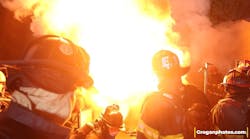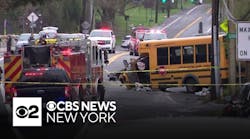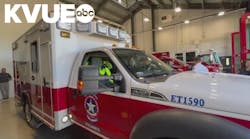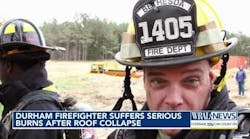It seems that everyday across America firefighters are being asked to handle a larger number of incidents, with a greater variety and with fewer resources. There are many great instructors across this country that instruct you how to get yourself out of trouble during incidents however, I would like to discuss preventing yourself from needing self-rescue or worse. Surviving the initial offensive attack is designed to get you thinking about how you the company officer can most effectively and safely prevent loss of life and conserve property and return safely.
To begin any offensive attack, you must arrive safely! As the company officer you must ensure the apparatus operator drives in a safe manner, controlling the speed and making sure intersections are clear before proceeding through them. Yeah, I know everyone wants to be first in, first water and that entire ego boosting crap, but no one wants to miss a fire either, especially because of an accident. Get there safe and make a difference! Upon arrival you need to determine where to spot your apparatus that will allow your company to operate effectively yet, still leave room for other rigs i.e. (truck companies). Either pulling past or stopping short of the involved structure should leave adequate room for others to spot and operate effectively.
Life Safety is the First Priority
Now that you're on the scene, your first and utmost priority is life safety! As the company officer determining where to place your first attack line, you have to know what life safety issues you're being faced with. At a minimum you should see for "yourself" three sides of the structure. Look for any occupants hanging from windows, signs of occupants in windows or doorways. Where is the smoke coming from, what does it look like? Does the structure have an obvious back entrance that has nothing showing from it? You will learn a lot by spending less than 30 seconds giving a quick look, and if it takes longer because of the size of the building, it's worth your time and life to spend the time doing so.
Once you've determined any life safety hazards and abated those, you now turn your attention to the construction of the structure. It is critical that you know basic building construction and if you don't or are fuzzy about it, go now and get a copy of Building Construction for the Fire Service by Francis L. Brannigan. This book will save your life and give you the mandatory knowledge to effectively operate inside structures that are being attacked by fire. Balloon-frame versus platform styles of wood-frame (type 5) structures, non-combustible masonry exterior with wood interior walls (type 3) ordinary construction versus fire resistive (type 1) construction, they all provide unique challenges and opportunities if you have the basic understanding of their construction.
Reading the Smoke
Next, let's read the smoke and understand what it's telling you. If the smoke is light in color and hangs around the opening or underneath the eaves, the light color is telling you most likely it's non-carbon based products that are burning (contents and not the structure) and the smoke hanging indicates there's little heat to the smoke, in other words the smoke is pressure driven. This should be a small incipient stage fire you can locate quickly and extinguish.
A darker black and/or brown smoke that's rising quickly into the sky when it exits the structure indicates the fire is much larger. The smokes color indicates carbon based products are burning and the structure's framing is most likely being attacked. The smoke rising indicates its heat driven and you should be prepared to flow larger amounts of water to control this one. Once you're inside the structure, determine what the smokes movement is. If the smoke is all the way to the floor and appears to be rising, the fire is below you. Likewise, if the smoke is heavier at the ceiling and appears to be pushing down, the fire is likely above you.
The quickest way to save the most lives is to put the fire out. If this is not possible, then protecting the interior stairways or hallways that lead to the bedrooms and escape routes must be protected. Once the structure is clear of the occupants, you have to determine if you can put the fire out or you should withdraw your crews. Remember - Risk a lot to save a lot, Risk a little to save a little!
Making the Offensive Attack
Anytime an offensive line is operating on the interior, you must have a back up line of equal size or larger and it needs to be as long, if not longer, in length. Locating the seat of the fire will be a challenge the attack line company officer will have to face. Once you've located the fire begin with operating your stream in a narrow or solid pattern above the fire and work your way to the base of the fire. This will help prevent the fire pushing up to the ceiling and back onto you and your company. Finish by sweeping the floor with the stream to cool the floor and remove debris that can injure your members. If a window is located in the fire room and its not been vented yet, do so with the stream and ventilate the room with your handline.
Make sure a secondary search for occupants is completed and adequate salvage and overhaul is performed. After the fire is out, take the opportunity to walk through the structure with your crew, discuss what went well and what didn't.
To make this work best requires adequate manning on your apparatus. Two firefighters inside a burning structure being watched by one firefighter outside, is not a safe or effective operation. If your dealing with manning issues and you arrive to find occupants trapped in windows or doorways, this must be your first priority before going on an expedition to find the seat of the fire. If you use the basic principles we've discussed, you will operate more effectively and safely.
Good luck, and be safe!
- Listen to Jeff Johnson on an Engine Company Roundtable on Training & Talk Podcast on Radio@Firehouse
Jeff Johnson is a Captain with the Kansas City, MO, Fire Department. He's currently assigned to Battalion 105 as a District Safety Officer. Johnson has 18 years of experience in the fire service. Johnson is a certified Fire Department Instructor and has taught classes that range from tactics and strategies to trench collapse rescue. He has coordinated and taught State Firefighter 1 and 2 courses. Johnson is a member of the International Association of Fire Fighters (IAFF) Health and Safety committee and Joint Chair for the Kansas City Missouri Fire Department Health and Safety committee.
